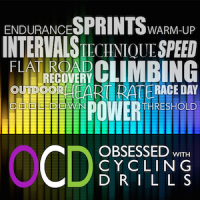Objective: Steady-State Sustainability, Threshold
Intensity: Zone 4–Zone 5
Cadence: 90–100 rpm
Description
Riding the line. Riding the sustainable limit. Riding on the edge. Statements like these give me the warm fuzzies—like a pair of warm, fuzzy slippers for your heart. Just as important as knowing your limit is the ability to arrive at or ramp up to the intended intensity. If we step on the gas too hard too soon, we risk blowing up; if we take too long to build to the target intensity, we risk short-changing the effort. Welcome to the On-Ramp: A fun way to learn how to approach grueling, leg-grinding, lung-searing sustainable efforts.


Im going to do a section of my next class with this drill in mind. Ill do a 30 second start up, and them 3.5 minutes of work and 4 minute recovery. Im going to do this twice in the middle of our work out. So here are my questions to you. Any feedback would be appreciated.
1. What the RPE during the hard work.
2. I was just going to not talk at all during the 3 minutes of work and maybe even get off my bike and join them in class. If you do talk any cues you suggest other than the regular motivational cues? I did pick, like you suggested, very upbeat and energetic music b/c I wasn’t going to cue much and just let them ride hard.
3. And during the 4 minute recovery song , I presume RPE is 5?
Thoughts? Thanks so much!
Hi Cynthia,
thanks for the great question.
Threshold efforts, by their very nature, are a perceived exertion of “Hard” to just above “Hard”. That would correspond to an RPE (RATE of perceived exertion) of 7–8.
The recovery between hard efforts like this in an interval workout should be EASY, so they have enough energy to do the next one (or two or five sets). That would correspond to an RPE of 2–3.
Many people “recover” at an intensity that is too hard, which in turn, lowers the potential effort of everything they do to what Tom and I like to call “Mediocre-ville”.
“Speaking” cues are some of the best for threshold efforts because it’s here that your ability to speak becomes very challenging. You could hold a conversation below threshold, however the closer you get to your threshold, the fewer words you can say before needing to breathe. When you are right at your threshold, you are too focused on your effort to want to talk. You might be able to say 3 to 5 words quickly. If you can say more, then you probably aren’t pushing hard enough. If you can only say 1 or 2 words, or grunt, then your intensity is too hard and you need to dial it back down.
You’ve given me a great idea to turn this into an Ask the Expert so more instructors can see the answers. Stay tuned. Thanks for the great idea!
Would this drill work with a shorter interval; like 2 minutes?
Absolutely Barbara! I have an entire profile dedicated to “arriving” at threshold. Each effort/interval is 2 minutes long. We slowly ramp for 30 seconds to a minute and then hold the intensity we achieved for another 60 seconds. It is an excellent way for riders to both confirm their steady-state threshold and ensure the best approach without blowing up.
Nice one, Tom, cheers
Thanks Caroline!